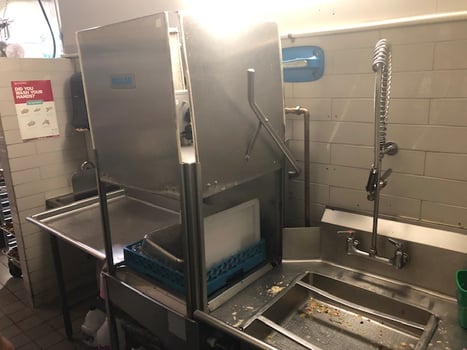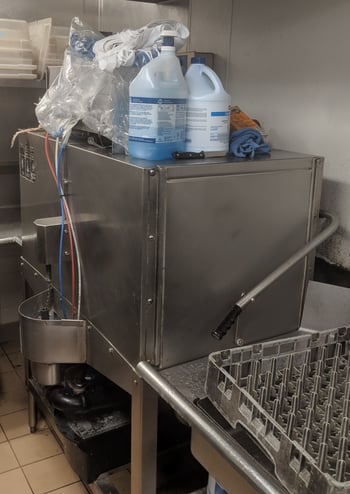Welcome to another 86 Repairs Guide! In this series, we provide valuable data and maintenance and troubleshooting information for the equipment and infrastructure found in your restaurant. We hope this information will help you and your team become more informed about repairs and maintenance (R&M)—and save you time and money along the way.
As a restaurant repair service, we partner closely with vendors and specialty technicians across the country to support our customers. But every restaurant has at least one “ceramic technician” on staff for an extremely important task: keeping dishes clean.
You might also know these technicians as dishwashers! Their job is to keep consumption surfaces sanitary for customers who come in for meals. If you’ve ever been out to eat and had the misfortune of a dirty knife at your place setting, you know just how important their job is.
But the truth is, in high-volume restaurants, they need the help of an appliance to get their job done. So in this Guide, you’ll discover the differences between leasing and outright owning restaurant dishwashers, learn easy dishwasher maintenance tips, find out how to troubleshoot common dishwasher problems, and pick up dishwasher parts and warranty advice.
Table of Contents
What is a restaurant dishwasher?
A restaurant dishwasher has the capacity to clean a large volume of dirty plates, glassware, utensils, and other objects with speed.
Restaurants will either own their dishwashers outright or lease them from a third party. The most common lessor—aka, the entity that actually owns the dishwashers—is Ecolab.
A dishwasher lessor typically handles all preventative maintenance and repairs to the appliance. They’ll also bring spare parts to have on hand for simple repairs that can be done by staff in-house. Typically, the lessor will also come through the restaurant at least once a month to calibrate the dishwasher.
We recommend that all restaurant dishwasher lessees laminate information and keep it close to the appliance so it’s easy to access when emergency strikes.
But for those operators who own their dishwashers, we’re coming clean on what to expect with repair-related expenses.

Numbers to know about restaurant plumbing
Restaurant dishwashers need to be connected to a water source in order to do their job. So, we consider this major appliance to be associated with plumbing.
In 2022, 86 Repairs customers spent an average of $592.80 on each vendor visit related to plumbing issues. A vast majority—92%—of plumbing problems were fixed during the first visit.
How can restaurant dishwasher owners reduce this extra expense of ownership? Let’s start with routine maintenance.
Routine maintenance for a restaurant dishwasher
Restaurant dishwashers benefit from daily, routine maintenance that will optimize performance and protect the equipment.
Cleaning
It’s important to note that dishwashers are a food contact surface. To protect the health of restaurant customers, dishwashers should be kept as clean as possible:
- Never place food or beverages on top of the dishwasher. It can easily spill into the appliance, causing a big, contaminated mess.
- Disassemble and clean the dishwasher every night at the end of service.
- Always follow specific manufacturer instructions for disassembly and reassembly. If even the smallest part is out of place, it can cause the dishwasher’s functionality to falter.
- Remove debris, like plastic straws, that can get stuck in the appliance and cause a breakdown. These are typically going to be found in the drain catch basket or water valves.
- Very large, commercial dishwashers have plastic curtains. These should also be washed at the end of every service since they’re also food contact surfaces.
Descaling
With all of the grease and grime that a dishwasher removes from flatware, some of it’s bound to create a clog. Plus, there’s the issue of water buildup—mineral deposits can prevent the dishwasher from dispensing water or properly draining.
Descaling (or deliming) the restaurant dishwasher can help eliminate this buildup. Use the manufacturer’s recommendation for the best chemical solution for the appliance, then follow this process weekly:
- Dispense the descaling chemical into an empty dishwasher.
- Run the “Descaling” cycle.
- Drain the appliance.
- Disassemble and clean the dishwasher as usual.
Chemical and temperature testing
Test the pH and chlorine levels of the dishwasher water at the start of every shift to ensure no customer is eating off of a dirty or otherwise unsafe surface. Make sure your restaurant has pH and chlorine test strips on hand and in stock so this becomes standard operating procedure.
Chemical treatments are especially important for dishwashers that don’t have heating components. In these models, following the exact procedures and frequency as listed in the owner’s manual is critical for proper sanitization.
Staff should also be testing the water temperature with a thermometer—if the water’s too cool, it won’t actually be sanitizing anything loaded in the dishwasher. This only needs to be done once per week, but keep an eye out for an error code on the dishwasher for water temperature in case something goes wrong in between manual checks.
Restaurants leasing dishwashers get a little bit of a break on this. The lessor will include chemical and heating checks as part of their routine visits.
Unfortunately, routine maintenance won’t wash away all of the problems that can afflict a dishwasher. When a problem pops up, try troubleshooting the issue before calling in a plumber for backup.

Restaurant dishwasher troubleshooting tips
These are the most common issues that happen with restaurant dishwashers. Learn why they happen—and how you can potentially fix them in-house.
Dishwasher isn't cleaning dishes
What’s the point in using a dishwasher if the flatware comes out dirty—and unusable for service? If you find that your dishwasher won’t properly sanitize items after running a cycle, the unit probably was not correctly reassembled after cleaning.
- Disassemble the appliance, following exact manufacturer instructions.
- Check for any major components, like a motor, that look or smell “off.”
- Reassemble the appliance, following exact manufacturer instructions.
If the dishwasher still doesn’t work correctly, call a plumber or the lessor for help.
Dishwasher doesn't get water
All that grime isn’t just going to rinse itself off. If water won’t make its way into your dishwasher,
- Verify the water line to the appliance is open.
- Disassemble the dishwasher, paying specific attention to the jets and arms that dispense water. Remove any clogs present.
Still no water, even though the line is on and no clogs are present? Time to contact a plumber or the dishwasher lessor.
Dishwasher won't turn on
If the dishwasher looks dead, don’t panic. Instead,
- Clean the dishwasher door sensors. The dishwasher won’t turn on if they’re dirty—it can’t recognize that the door is closed!
- If cleaning the door sensors doesn’t allow the dishwasher to start, check the breaker. Use these Troubleshooting restaurant electricity steps for explicit guidance on how to do it safely.
- Power successfully getting to the appliance, but it still won’t turn on? The dishwasher could have a part or two out of place. Disassemble, clean, and reassemble as usual.
If the dishwasher still won’t turn on, you’ll need to contact a plumber or your lessor for further assistance.
Restaurant dishwasher warranties and parts
Restaurants that lease their dishwashers shouldn’t need to worry about warranty status or parts replacement. (After all, one of the benefits of leasing equipment is that the lessor is liable for any problems that may occur with the appliance!) Many lessors will also provide common spare parts, like jet plugs and plastic curtains, for restaurants to have on hand.
If the restaurant owns the dishwasher outright, you’ll also want to keep small parts around to save time and money on a vendor service call. Replacing something like a threaded screw is simple—and inexpensive—to do yourself.
Warranty-wise, every manufacturer’s coverage is different. It’s very common for restaurant dishwasher warranties to cover the electronic board and motor components for a longer length of time than the heating components. Always check the specific warranty coverage for your dishwasher’s make and model before proceeding with a repair.
A final note on restaurant dishwashers
Routine maintenance, smart troubleshooting, and knowing warranty coverage can help restaurant dishwasher owners break the cycle of spending too much money on repairs. We hope this Guide gives you and your team a clean slate when it comes to dishwasher R&M.